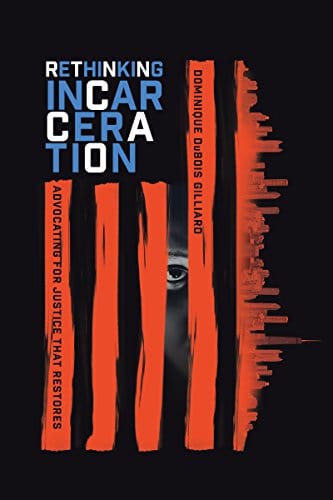Title: Rethinking Incarceration: Advocating for Justice that Restores
Author: Dominique DuBois Gilliard
Publisher: Downers Grove, IL: InterVarsity Press, 2018
Pages: 199 plus end notes
Reviewer: Kyuboem Lee
Incarceration has profoundly shaped countless urban communities across the American landscape, and this issue has received deserved attention in recent years, especially in the wake of Ferguson and the Black Lives Matter movement, through the publication of Michelle Alexander’s The New Jim Crow (2010) and the publication of Just Mercy by Bryan Stevenson (2014)1, which was recently made into a major motion picture (see the review of the movie in this issue here). However, although those who are a part of “inner city” communities or those who pastor African American or Hispanic congregations are all too familiar with the issues and the people enmeshed in the incarceration system, churches in the more well-to-do communities (whether suburban or urban) often have little or no familiarity with this world.
Author, pastor and denominational activist (in the Evangelical Covenant Church) Dominique Gilliard addresses this lack with his book, Rethinking Incarceration, and it provides an important education for the church in America—especially with regard to how the church has historically acted as a contributor to the present condition; how the church continues to be complicit in the forces that have turned the US into the number one incarcerator in the world; and how the church can and should make a pivot and help to lead the way towards a more just system. In the process, Gilliard issues a prophetic call to the church to return to its calling to proclaim the gospel of the kingdom that includes at its heart proclaiming freedom for the prisoner and entering into solidarity with those behind bars (Luke 4:18; Matt 25:36).
Part 1 tells the story of how our current state of mass incarceration came to be, breaks down the inner workings of current incarceration policies, and reveals the devastating effects of mass incarceration on many urban communities. Many readers might be familiar with diverse snippets of the story, but Gilliard narrates a comprehensive tale that fills in many gaps of understanding and helps us make sense of what happened and how we got here.
He tells the story of how the War on Drugs ended up flooding jails and penitentiaries with nonviolent offenders, especially black and brown youth from communities struggling with poverty, overwhelmingly many of them before they reached adulthood. This politically popular policy had the effect of extracting the young people from families and communities that nurtured them and needed them, devastating not only individuals but whole communities. He tells the story of how slavery continued its life, after it was legally abolished, in the form of sharecropping, lynching, and “black codes”—laws meant to exert racial control over African Americans, such as apprenticeship laws that in effect enslaved black orphans and children whose parents were deemed unfit; laws that criminalized black migration across state borders; and vagrancy laws. The intended effect of these “black codes” was racial intimidation and criminalization of blackness.2 Convict leasing, by which vast wealth was made on the backs of the incarcerated, and which Gilliard labels “modern slavery,” was also a part of this story. So were the violent and oppressive conditions of places like the infamous Angola prison in Louisiana. Prison labor still goes on today, continuing an exploitative system that profits capitalists who saw an opportunity in the prison system.
Gilliard also educates the reader on the inner workings of the prison system—the “pipelines” that feed the prisons. These are the mental health pipeline (incarcerating the mentally ill), the privatization of prisons (which provides a profit incentive to mass incarceration), and the immigration pipelines (incarcerating the immigrants, especially the undocumented immigrants coming into the US through the southern border).
Perhaps the most devastating to urban communities of color is the school-to-prison pipeline. Many young people of color growing up in the impoverished neighborhoods of our cities face a high likelihood of finding themselves not in classrooms, as they should expect, but in the juvenile justice system, in the courts, in detention centers, and in penitentiaries. An increased police presence in schools in recent decades did not bring an increased safety to these young people, but a higher probability of incarceration.
These are pressing issues not only for the U.S. society, though Gilliard mainly focuses his discussions here. The prison industrial complex that the U.S. has innovated and established has become the model to follow for many other societies around the world for its efficiency and lucrative profit. Its ills have also been copied and repeated globally.3 American incarceration policies, and the American church’s influence on those policies, whether for good or for ill, have global consequences.
In Part 2, Gilliard turns his focus on the church’s relationship with incarceration; it is a checkered story. While he points to many various individual prison chaplains who genuinely and sacrificially served the cause of the gospel in prisons and faithfully worked for the good of those behind bars, he can also point to others who were decidedly less compassionate. Moreover, evangelicalism proved to be an ardent supporter of “law and order” policies that directly contributed to mass incarceration. When evangelicals did get involved in prison ministries, they tended to put their singular focus on personal evangelism and individual conversions and to turn a blind eye to being the conscience of the criminal justice system and to championing prison reform.
Of particular importance is Gilliard’s discussion of the doctrine of penal substitutionary atonement—he asserts that this theory of the atonement led many Christians to give religious justification for unjust and inhumane practices in the incarceration system. It focused “not merely on satisfaction but on retribution—paying a legal penalty for sin.”4 When the state interpreted this doctrine to mean that crime and sin were synonymous, state-sanctioned violence and punishment could then be portrayed as a good whose origin was divine—incarceration and punishment for crimes handed down by the state were God’s instruments for redemption of sinners. For Gilliard, the doctrine of penal substitution provided the theological underpinnings of retributive justice (and thereby cover for racial control) as the main feature of social policy in the U.S. Moreover, he finds it highly problematic as Christian theology, since “restoration, not retribution, is the hallmark of God’s justice and is God’s final word in history.”5
Instead of penal substitution, Gilliard looks to an alternative atonement theory of satisfaction and the biblical theology of pursuing shalom as providing theological framework for restorative justice. Justice, in this construction, is not primarily focused on the punishment of the wrongdoer, but the restoration of relationships and the healing of community. Punishment and harsh consequences are not excluded from restorative justice, but the larger goal of restoration, reintegration and redemption is always in view. It is to restorative justice that Gilliard points as the Christian option, over against retributive justice, the unjust status quo of the land, which Christians have too often supported wrongheadedly.
It is the beyond the scope of this review to wade into the often heated current theological discussions surrounding penal substitutionary atonement (some of the voices engaged in this conversation are included elsewhere in this issue). Some questions as it applies to incarceration will have to suffice for now.
Does the doctrine of penal substitutionary atonement inevitably and necessarily lead to retributive justice and to an oppressive system of mass incarceration? Or is it possible that penal substitution might be conceived in a way that could support restorative justice? Can penal substitution satisfy the contextual question posed by those who have been deeply scarred by mass incarceration of whether it truly proclaims good news of Jesus to them, or will it be found wanting?
Other questions remain. How are Christians committed to the authority of Scriptures to contend with biblical teachings that appear to articulate penal substitution? Does jettisoning penal substitution ensure a more just Christian vision of criminal justice? Will a satisfaction theory of atonement lead to a robust pursuit of shalom?
These are serious questions with which theologians and the church must grapple. Our theology must be faithful to the witness of Scripture, but it must also bear good fruit in this world—in this case, in the realm of how we as a society treat those who broke the law. It will also shape Christian relationships with our neighbors behind bars. Too often, the incarcerated populations have been out of the church’s sight and mind when the Scriptures give clear commands to followers of Jesus to visit those in prison–the Scriptures do not give this to only a few who feel a sense of calling to this population, but to the whole church. A good Christian theology will not allow the incarcerated to be excluded from Christian community nor the issues surrounding incarceration to not occupy a prominent role on the church’s mission and discipleship agenda.
Gilliard concludes his book with stories of hope—of Christians and churches who are leading the way by dedicating themselves to educating the incarcerated, to providing community restorative courts that put principles of restorative justice into action at the local level, to legally advocate for those who would otherwise be without any legal help, to intentionally employ the formerly incarcerated through creative social enterprise, and to seek out and serve those returning to community as well as families of the incarcerated.
As inspiring as these stories are, we recognize that they should not simply stay as outliers in the life of the church. Instead, inclusion of the incarcerated into the church community must become an ordinary feature of everyday life in the kingdom if the church is to be faithful to its mission. Towards that end, Gilliard’s Rethinking Incarceration is an invaluable resource.
The issues dealt with in this book have always been urgent, especially for the communities that have borne the devastating effects of oppressive criminal justice policies. But in the wake of George Floyd’s death at the hands of a Minneapolis officer, however, these issues have exploded into national protests. Church leaders who have not been educated on these issues have a lot of catching up to do–learning from Gilliard may well be an excellent place to start.
Notes
1 Michelle Alexander, The New Jim Crow: Mass Incarceration in the Age of Colorblindness (New York: The New Press, 2010), and Bryan Stevenson, Just Mercy (New York: Random House, 2014).
2 Page 33.
3 See, for example, Baz Dreisinger, Incarceration Nations: A Journey to Justice in Prisons Around the World (New York: Other Press, 2016).
4 Page 155.
5 Christopher Marshall, Beyond Retribution: A New Testament Vision for Justice, Crime, and Punishment (Grand Rapids: Eerdmans, 2001), 65-66, cited on page160.


